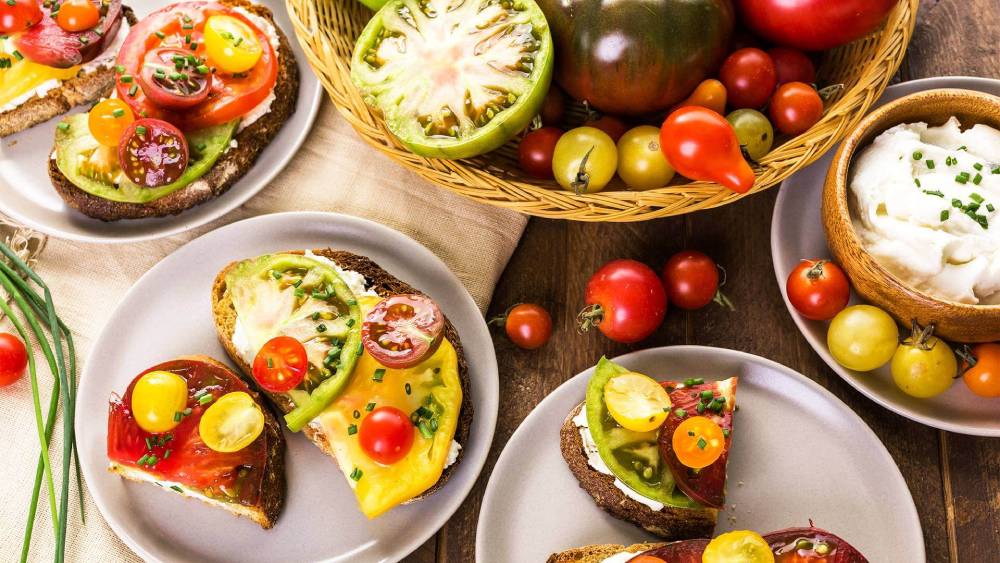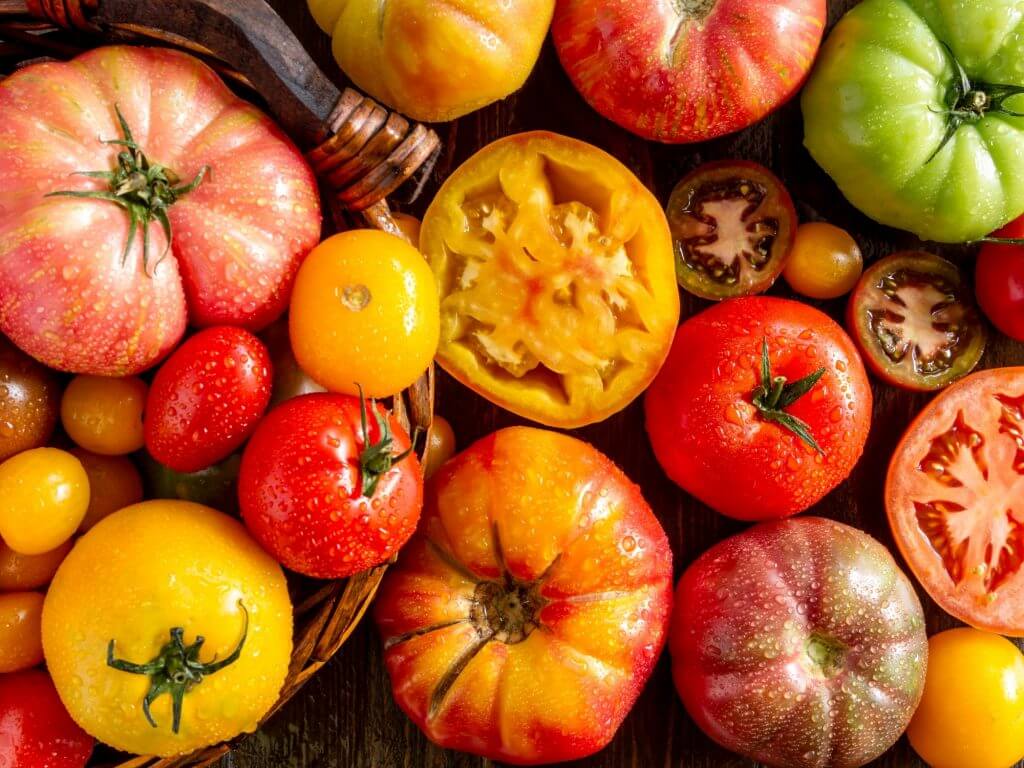A Chef’s Essential Guide to Heirloom Tomatoes
The intriguing colors, the odd shapes, the maximum flavor punch. Sounds familiar? We certainly hope so!
Most of us have probably laid our eyes upon an uneven and multicolored bunch of Heirloom tomatoes at some point in our lives but settled for some shiny-red, perfectly round Beefsteak tomatoes instead. But was that truly the best choice? We’ll have to figure out how Heirloom Tomatoes are intrinsically different from their picture-perfect counterparts to answer this question.
What’s the Big Fuss? What Makes Heirloom Tomatoes so Unique?
For one thing, the chances are that your regular “perfect” tomatoes (hybrid tomatoes) have been more or less bred for purposes: high yield, flawless appearance, and ability to withstand longer, lonelier days on supermarket shelves to cut down costs and minimize food waste.
Meanwhile, heirloom tomatoes are the infamous kings of juiciness and flavor. They’ve been allegedly grown by local farmers with great devotion to their taste profiles. That is to say, aesthetics or extended shelf life were not the primary concern in their growth – which sets them apart from the hybrid varieties you’ll find at the grocery store’s produce section. According to UF/IFAS, “much less consideration has been given to heirloom cultivars with regard to marketable aesthetics (e.g., likelihood to blemish, consistent shape, uniform color, etc.) and prolonged durability (e.g., thicker cell walls, slower cell breakdown, etc.).”
Long story short, the myth goes that farmers “hand-pick” seeds from yummiest tomatoes only — season after season after season — to yield the richest, delicious tastes and textures. It’s good to know that, while taste seems to be the highlight with heirloom varieties, some cultivators also keep an eye on secondary traits such as size, consistency, succulence, shape, and colors.
Another crucial aspect many heirloom growers pride themselves on is their loyalty to natural pollination methods (self-pollination and open-pollination).
The tricky part is that some non-authentic producers can abuse such claims to market their tomatoes as “heirloom,” but we’ll discuss this in a subsequent point.
When are Heirloom Tomatoes in Season?
The best time to check your favorite wholesale suppliers for Heirloom tomatoes in the U.S. is late summer into the fall. Local varieties start appearing from late July throughout early August. So just about now is the best time to experiment with the different heirloom varieties out there and add them to your restaurant’s menu.
The Forever-Evolving Color Variety of Heirloom Tomatoes
With real heirloom tomatoes, you get to choose from myriad hues and colors: reds, pinks, browns, oranges, yellows, greens, and purples, sometimes in fun and unexpected combinations (striped, variegated). Just imagine how gorgeously they could mix in a Panzanella or Caprese Salad made with peak-season heirloom tomatoes.
A New World of Unique Taste Profiles
As for the taste, sampling heirloom tomatoes is an adventure in and of itself. You can’t quite sum up the incredible variety out there, mainly because each grower promotes unique qualities with different heirloom crops. You’d have to look into each particular type and weigh up different samples against what heirloom growers claim—all to ensure you’re getting the best for your restaurant. Here’s what to expect from four common heirloom varieties:
- The largely-acclaimed Brandywine (a pink heirloom variety) is characterized by balanced acidity and a gust of rich, succulent sweetness that has you thinking, “Ah yes, homegrown”!
- Cherokee Purple usually features a more complex taste profile: a slightly sweet aftertaste follows the initial smokiness.
- Juane Flamme features a lovely apricot-orange exterior. It’s small like a plum, sweet and softly tropical, low-acid, and jam-packed with juiciness.
- Aunt Ruby’s Green has high acidity balanced by sugar and a terrific burst of juiciness.
For more heirloom taste profiles, we recommend this blog from Farm to Jar.
Other Famous Heirloom Varieties
-
- Speckled Roman
- Rosella Purple
- Anna Russian
- Brandywine Red
- Cherokee Purple
- Cherokee Chocolate
- Lucky Cross
- Mr. Stripey
- Blondkopfchen
- Dwarf Emerald Giant
-
The Perks of Bringing Heirloom Tomatoes to your Restaurant
The more taste and texture varieties you work with, the more creative you can get. As we’ve seen, these rich seasonal wonders are all about variety! Heirloom tomatoes are astounding in soups, salads, sauces, ketchup, kebabs, lasagna, toast, pizza, frittata — it’s all up to your master vision, really.
So perhaps replace the bright-red but rather mealy, watery hybrid tomatoes that might have quietly made their way into your recipes with some perfectly imperfect, colorful, and flavorful heirloom tomatoes. Your diners will undoubtedly notice and respond positively to the change! What’s more, you can also adorn the heirloom-based dishes on your menu with a small but much-appreciated “locally-sourced ingredients” label. The thing is, heirloom tomatoes have to be local; if they’re not, then you’re not looking at the real deal.
The Real Deal: Where Can I Buy High-Quality Heirloom Tomatoes?
Making eye-catching but oftentimes false claims about their produce is a marketing practice most familiar to many large farms and distributors. Unfortunately, many loosely-regulated labels (natural, organic, local…you know the drill by now) are easily abused by those eager to ride the understandable hype for high-quality produce.
But don’t let that discourage you. One of the best things you can do is look for trustworthy restaurant suppliers, search for information on their website, or directly call in to ask where they source their heirloom tomatoes from. If they name farms in your region (as close to your restaurant as possible!), then you are off to a good start. Make sure to also inquire about growth and harvest practices for heirloom varieties to ensure you’re actually getting what you’re paying for.
Here’s Where to Start!
Did we say local and trustworthy? Riviera sources Large & Baby Heirloom Tomatoes directly from the two-centuries-old Hepworth Farms found on the Hudson River, NY. You can read more about their long tradition on their official website.
So if you own a restaurant in the Tri-State Area, give these versatile and delicious wonders a chance. You won’t be disappointed!

